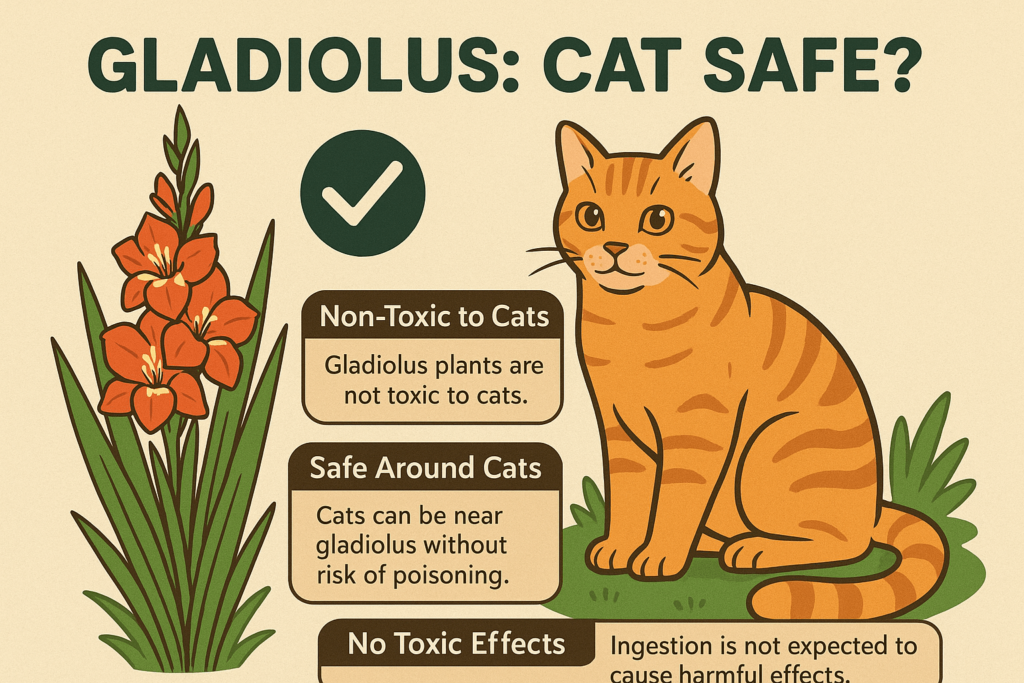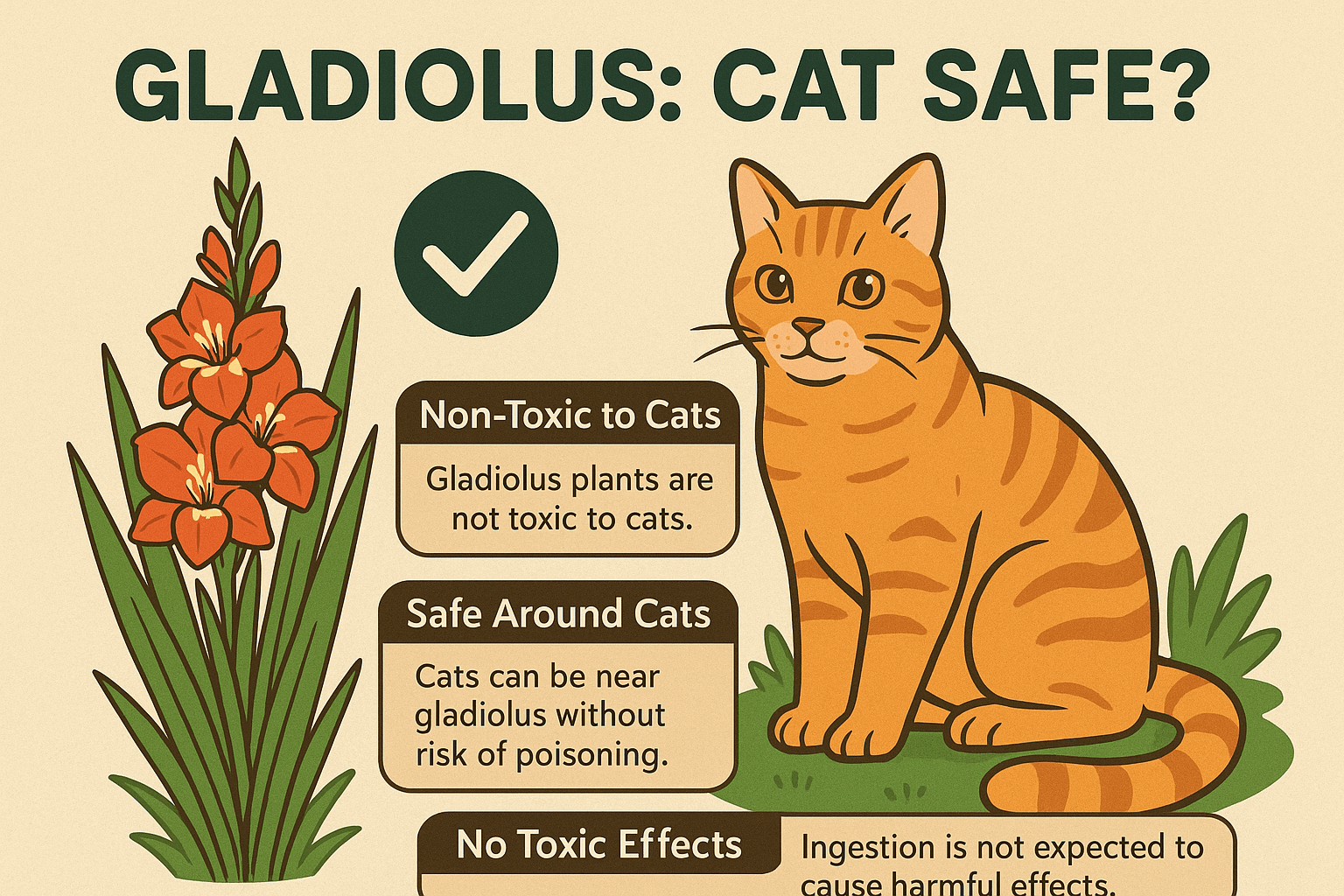Is Gladiolus Cat Safe? What Every Pet Owner Needs to Know
Gladiolus flowers are a stunning addition to any garden or floral arrangement, known for their vibrant colors and elegant spikes. However, if you’re a cat owner, it’s essential to consider whether these beautiful blooms pose any risks to your feline friend. Cats are naturally curious creatures, and their tendency to nibble on plants can sometimes lead to trouble. While gladiolus isn’t as toxic as some other common plants, it still warrants caution. In this blog post, we’ll explore everything you need to know about gladiolus and its potential effects on cats, along with tips to keep your pet safe while enjoying the beauty of these flowers.
Expert Insight: Why Gladiolus Poses a Risk to Cats
“We can’t be sure exactly why gladiolus is toxic to cats and other pets because the gladiolus’ toxic principles are unknown. The bulb is the most toxic part, but eating any part of the plant can cause cats to become sick.”
Understanding the Risks of Gladiolus for Cats
While gladiolus isn’t among the most dangerous plants for cats, it does contain compounds that can cause mild to moderate irritation if ingested. Understanding these risks is key to ensuring your cat’s safety.
Toxic Compound: Calcium Oxalate Crystals:
Gladiolus contains calcium oxalate crystals, which can irritate a cat’s mouth and digestive system if chewed or swallowed.Symptoms of Ingestion:
Signs of gladiolus exposure include drooling, vomiting, diarrhea, and difficulty swallowing due to oral irritation.Severity Depends on Quantity Consumed:
Small nibbles may only cause mild discomfort, but larger ingestions can lead to more significant health concerns.Bulbs Are More Toxic Than Flowers:
The bulb of the gladiolus plant contains higher concentrations of toxins compared to the leaves or flowers.Cats Are More Vulnerable Than Dogs:
Cats lack certain liver enzymes that help process plant toxins, making them more susceptible to adverse effects.
By understanding these risks, you can take proactive steps to minimize potential harm and ensure your cat stays healthy around gladiolus plants.

How to Keep Your Cat Safe Around Gladiolus
Prevention is the best approach when it comes to protecting your cat from harmful plants like gladiolus. Here are some practical tips to create a safer environment for your pet.
Place Plants Out of Reach:
Position gladiolus flowers in areas where your cat cannot access them, such as high shelves or hanging baskets.Use Barriers or Fencing:
If gladiolus is planted outdoors, consider using fencing or barriers to prevent your cat from approaching the area.Supervise Outdoor Time:
When allowing your cat outside, supervise their activities to ensure they don’t wander near toxic plants.Provide Cat-Friendly Alternatives:
Offer safe, non-toxic plants like catnip or spider plants to satisfy your cat’s curiosity and discourage them from exploring dangerous ones.Educate Family Members:
Ensure everyone in your household understands the risks of gladiolus and knows how to keep your cat safe.
Taking these precautions helps reduce the likelihood of accidental ingestion and ensures a harmonious coexistence between your cat and your plants.
Check this guide 👉Is the Corn Plant Cat Safe? Best 7 Health Tips!
Check this guide 👉Are Tulips Cat Safe? Best 7 Expert Tips!
Check this guide 👉Is Ranunculus Cat Safe? Best 7 Expert Tips!
Safe Practices Around Gladiolus | Signs Your Cat May Have Ingested Gladiolus |
|---|---|
Keep plants out of reach | Excessive drooling |
Use barriers for outdoor plants | Vomiting |
Supervise your cat during outdoor time | Diarrhea |
Provide cat-safe alternatives | Difficulty swallowing |
Educate family members about risks | Pawing at the mouth |
What to Do If Your Cat Eats Gladiolus
If you suspect your cat has ingested part of a gladiolus plant, quick action can make all the difference. Follow these steps to address the situation effectively.
Assess the Situation Immediately:
Check your cat for visible symptoms like drooling, pawing at the mouth, or vomiting. Look for evidence of chewing on the plant.Remove Any Plant Material:
Gently clean your cat’s mouth with water to remove residual plant material and reduce irritation.Contact Your Veterinarian:
Call your vet for advice, even if symptoms seem mild. They can guide you on whether further treatment is necessary.Monitor Your Cat Closely:
Watch for worsening symptoms over the next 24 hours, including lethargy, loss of appetite, or persistent vomiting.Avoid Home Remedies Without Guidance:
Refrain from administering medications or treatments without consulting a professional, as some remedies can worsen the situation.
Promptly addressing potential ingestion ensures your cat receives the care they need and minimizes long-term effects.
Non-Toxic Alternatives to Gladiolus for Cat Owners
If you’re concerned about the risks associated with gladiolus, consider adding pet-safe plants to your home or garden instead. These alternatives allow you to enjoy greenery without compromising your cat’s safety.
Spider Plants (Chlorophytum comosum):
Spider plants are easy to care for and completely safe for cats, despite their grass-like appearance.Boston Ferns (Nephrolepis exaltata):
These lush, fern-like plants are non-toxic and add a touch of elegance to any space.Catnip (Nepeta cataria):
A favorite among felines, catnip is perfectly safe and can provide hours of entertainment for your cat.African Violets (Saintpaulia):
With their colorful blooms, African violets are a beautiful, cat-friendly option for indoor gardens.Orchids (Phalaenopsis spp.):
Orchids are not only stunning but also non-toxic, making them an excellent choice for households with pets.
Switching to these pet-safe options allows you to enjoy nature’s beauty while keeping your feline companion out of harm’s way.
Common Misconceptions About Gladiolus and Pets
There are several misconceptions about gladiolus and its effects on pets. Clearing up these myths helps pet owners make informed decisions about plant safety.
Myth: All Parts of Gladiolus Are Equally Toxic:
Reality: The bulbs are more toxic than the flowers or leaves, so focus on keeping bulbs secure.Myth: Gladiolus Is Safe Because It’s Not on Every Toxic Plant List:
Reality: Just because it’s not always listed doesn’t mean it’s risk-free—moderation is key.Myth: Cats Will Avoid Toxic Plants Instinctively:
Reality: Cats are curious and may investigate plants regardless of their toxicity.Myth: A Small Bite Won’t Cause Harm:
Reality: Even small bites can cause irritation, depending on the individual cat’s sensitivity.Myth: Only Outdoor Cats Are at Risk:
Reality: Indoor cats can also encounter toxic plants if they’re brought inside.
Dispelling these myths empowers pet owners to take appropriate precautions and prioritize their cat’s well-being.
Benefits of Choosing Pet-Safe Plants
Opting for pet-safe plants not only protects your furry friend but also enhances your home environment in meaningful ways.
Peace of Mind:
Knowing your plants are harmless allows you to relax without constant worry about your cat’s safety.Encourages Playful Exploration:
Safe plants like catnip encourage natural behaviors like sniffing, chewing, and playing.Improves Air Quality:
Many pet-safe plants, such as spider plants and Boston ferns, help purify indoor air.Adds Aesthetic Value:
Non-toxic plants come in a variety of shapes and colors, enhancing your décor without risks.Strengthens the Bond with Your Cat:
Sharing a safe, enriching environment fosters trust and companionship between you and your pet.
Choosing pet-safe plants creates a win-win scenario for both aesthetics and animal welfare.
How to Train Your Cat to Avoid Dangerous Plants
Training your cat to steer clear of potentially harmful plants like gladiolus can prevent accidents and promote a safer home environment.
Redirect Their Attention:
Distract your cat with toys or treats whenever they show interest in unsafe plants.Create Negative Associations:
Use harmless deterrent sprays on plants to make them unappealing to your cat.Reward Good Behavior:
Praise and reward your cat when they ignore dangerous plants to reinforce positive habits.Designate a Cat Zone:
Set up a specific area with safe plants and toys to satisfy your cat’s curiosity in a controlled setting.Be Consistent with Training:
Regular reinforcement ensures your cat learns boundaries over time.
With patience and consistency, training can help your cat develop healthier habits and avoid risky behaviors.
Frequently Asked Questions About Gladiolus and Cats
Is gladiolus highly toxic to cats?
No, gladiolus is considered mildly toxic, but ingestion can still cause discomfort and irritation.
Can I grow gladiolus indoors with cats?
Yes, but it’s crucial to place the plant where your cat cannot access it.
What parts of the gladiolus are most dangerous?
The bulbs contain higher toxin levels compared to the leaves and flowers.
How quickly will symptoms appear if my cat eats gladiolus?
Symptoms typically appear within a few hours of ingestion.
Are there any long-term effects from gladiolus ingestion?
Most cases result in temporary discomfort, but severe ingestions should be evaluated by a vet to rule out complications.
Balancing Beauty and Safety for Your Feline Friend
While gladiolus adds undeniable charm to gardens and homes, its potential risks to cats cannot be ignored. By understanding the dangers, taking preventive measures, and knowing how to respond in case of ingestion, you can enjoy these striking flowers responsibly. For those seeking peace of mind, switching to pet-safe alternatives offers a worry-free way to incorporate greenery into your living space. Ultimately, being informed and proactive ensures that both your love for plants and your devotion to your cat can coexist beautifully.
Can a Cat Die from a Cold? Best 7 Expert Tips! Learn how to identify, treat, and prevent feline colds while understanding when to seek veterinary care for your cat’s health.
Cat Screaming for Food: Best 7 Expert Tips! Discover effective strategies to manage your cat's food-related vocalizations and create a peaceful feeding routine.
Aspiration Pneumonia in Cats: Best 7 Expert Tips! Discover causes, symptoms, and treatment advice to protect your cat’s respiratory health and ensure a speedy recovery.
Hip Dysplasia in Cats: Best 7 Expert Tips! Discover expert advice on managing hip dysplasia in cats, from symptoms and prevention to treatment options for a happier, healthier feline life.





